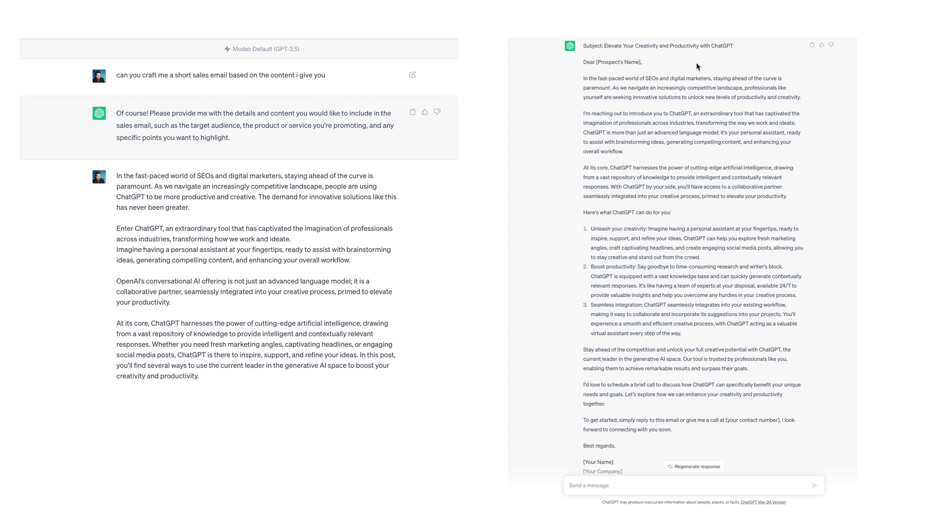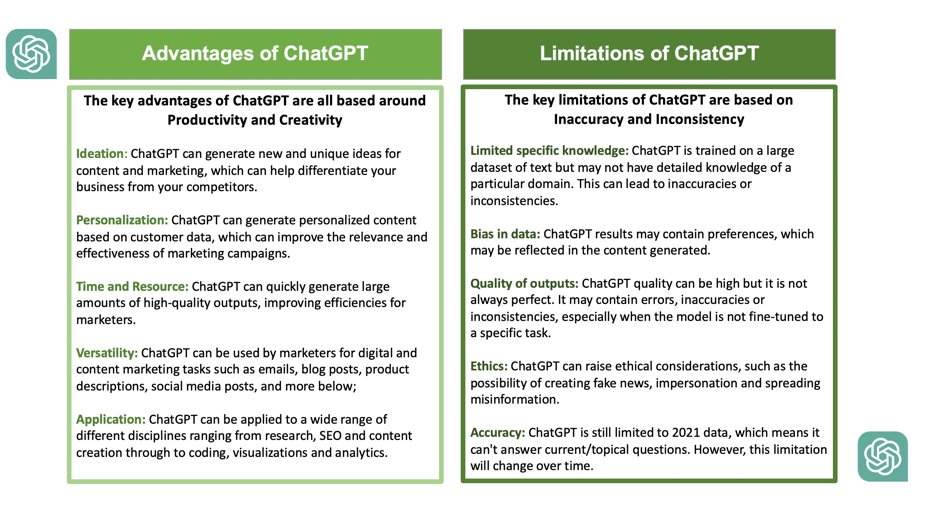
ChatGPT can be a powerful creative tool when employed in the right way. Case in point: I asked ChatGPT to write an introduction for this article.
Here’s what it gave me:
In the fast-paced world of SEO pros and digital marketers, staying ahead of the curve is paramount.
As we navigate an increasingly competitive landscape, people are using ChatGPT to be more productive and creative. The demand for innovative solutions like this has never been greater.
Enter ChatGPT, an extraordinary tool that has captivated the imagination of professionals across industries, transforming how we work and ideate.
Imagine having a personal assistant at your fingertips, ready to assist with brainstorming ideas, generating compelling content, and enhancing your overall workflow.
OpenAI’s conversational AI offering is not just an advanced language model; it is a collaborative partner, seamlessly integrated into your creative process, primed to elevate your productivity.
At its core, ChatGPT harnesses the power of cutting-edge artificial intelligence, drawing from a vast repository of knowledge to provide intelligent and contextually relevant responses.
Whether you need fresh marketing angles, captivating headlines, or engaging social media posts, ChatGPT is there to inspire, support, and refine your ideas.
In this post, you’ll find several ways to use the current leader in the generative AI space to boost your creativity and productivity.
 Screenshot from ChatGPT, June 2023
Screenshot from ChatGPT, June 2023As ChatGPT advances – GPT3.5, GPT4, Premium – more and more plugins are becoming available, more integrations are happening, and outputs will be fine-tuned based on version control.
Read more on SEJ: GPT-4: How Is It Different From GPT-3.5?
Hence it will always be evolving for the considerable future.
How ChatGPT Can Be Applied To Different Disciplines
Generative AI, such as ChatGPT, is being used across many areas of business.
 Image from McKinsey, June 2023
Image from McKinsey, June 2023Source.
In addition, ChatGPT is being used in myriad ways across the spectrum of marketing disciplines.
Here are a few examples across eight of them:
Content Marketing
- Generating creative content ideas and headlines.
- Providing suggestions for engaging blog post introductions.
- Assisting in content optimization for SEO purposes.
- Helping with content planning and editorial calendars.
Social Media Marketing
- Crafting engaging social media captions and posts.
- Analyzing sentiment and trends in social media conversations.
- Assisting in influencer identification and partnership strategies.
- Providing recommendations for social media content calendars.
SEO
- Assisting with keyword research by suggesting relevant keywords to expand your list.
- Analyzing content and suggesting SEO improvements.
- Assisting in on-page optimization, meta tags, and URL structures.
- Providing insights on backlink analysis and link-building opportunities.
Email Marketing
- Generating compelling subject lines and email copy.
- Personalizing email content for different customer segments.
- Assisting in A/B testing and optimization of email campaigns.
- Analyzing email campaign performance and suggesting improvements.
Paid Advertising
- Assisting in ad copywriting and ad creative ideas.
- Optimizing ad targeting and audience segmentation.
- Analyzing ad performance metrics and suggesting campaign improvements.
- Providing insights on bidding strategies and budget allocation.
Read more on SEJ: ChatGPT & PPC: 7 Ways SEMs Can Leverage AI Tools
Market Research
- Conducting sentiment analysis on customer feedback and reviews.
- Analyzing competitor strategies and identifying market trends.
- Assisting in customer persona development and segmentation.
- Providing insights on new market opportunities and niche targeting.
Branding And Positioning
- Helping with brand storytelling and messaging.
- Analyzing brand sentiment and perception.
- Assisting in brand positioning strategies and differentiation.
- Providing recommendations for brand voice and visual identity.
Marketing Analytics
- Assisting in data analysis and visualization for marketing campaigns.
- Generating reports and dashboards for key performance indicators (KPIs).
- Analyzing website traffic patterns and user behavior based on input data.
- Providing insights on customer journey mapping and conversion optimization.
The Limitations Of ChatGPT
While ChatGPT is a powerful language model with various applications, it does have some serious limitations that marketers need to keep in mind.
For starters, it lacks real-time context, and how a question or prompt is phrased can significantly impact the quality and accuracy of the response. It’s essential to experiment with different phrasings to achieve the desired response or level of detail.
 Image created by author, June 2023
Image created by author, June 2023And while ChatGPT has access to a vast amount of information, it doesn’t possess real-world experience or common sense knowledge. It can sometimes generate plausible responses that may not be accurate or factual.
Because it learns from the data it is trained on, it may produce biased or inappropriate responses.
ChatGPT can’t perform physical actions or execute code directly in the real world.
While it can produce code or written text for social media captions, for example, you still need to test and implement the code and upload the social content to a scheduler.
It’s an assist, not an alternative solution, to most digital marketing operations.
How To Get The Best Out Of ChatGPT
Prompt engineering is essential for optimizing the performance and output quality of language models like ChatGPT.
Remember, too, that ChatGPT excels in interactive conversations – it’s not meant to simply spit out instant answers.
Engaging in a back-and-forth dialogue, providing feedback, and iterating on the generated responses will help you guide ChatGPT toward higher quality, more useful outputs. Here are a few tips for doing just that:
Provide Specific Instructions
When engaging with ChatGPT, be as specific as possible in your prompts. Clearly state what you’re looking for, your desired format, or any specific requirements.
This helps ChatGPT understand your needs and generate more accurate and targeted responses.
Iterate And Refine
Experiment with temperature and length: ChatGPT has two parameters that can be adjusted to modify its behavior.
The “temperature” parameter controls the randomness of the responses, with higher values (e.g., 0.8) leading to more diverse outputs, while lower values (e.g., 0.2) make the responses more focused and deterministic.
Similarly, you can specify the desired response length to ensure the generated content aligns with your requirements.
Use System Messages To Gently Instruct Or Guide ChatGPT
Placing important instructions or context in a system message lets you influence the model’s behavior throughout the conversation.
System messages are typically displayed at the beginning of the interaction and can help set the tone and direction of the conversation.
An example of a system message might be, “I want you to act as a social media manager. Write a 500-word social strategy, including sections on choosing the right platforms, content development, and community management strategy.”
Be Critical And Validate Outputs
While ChatGPT is highly advanced, it’s important to critically evaluate its responses.
Double-check facts, review the generated content for accuracy, and ensure the outputs align with your requirements and brand guidelines.
ChatGPT may occasionally produce incorrect or nonsensical responses, so validating its outputs is crucial.
Check out Vincent Terrasi’s How To Write ChatGPT Prompts To Get The Best Results for more.
Using ChatGPT In Specific Ways
How To Use ChatGPT As A Researcher
ChatGPT is a great research assistant, with one critical caveat: you cannot take its output as indisputable and must fact-check everything. It’s been known to “hallucinate” by making up information and even citations.
It also doesn’t have access to the live web. So what’s the point, you might ask?
While it cannot give you live keyword data, ChatGPT can help speed up keyword research processes by generating keyword ideas, listing semantically related keywords, sorting lists in different ways, suggesting keywords based on audience personas, and more.
You can use it in content research to suggest alternative viewpoints for blog posts, product descriptions, or whitepapers. Ask ChatGPT to explain the topic from the perspective of four or five different types of people – a customer, product developer, researcher, and salesperson, for example.
This can help you surface pain points and user benefits you may not have thought of based on your own limited experience and perspective on the topic.
Some other ways to use ChatGPT for research include:
- Analyzing social media conversations related to your brand, industry, or campaigns to generate content ideas and hashtags. Remember, you must compile and clean the data, as ChatGPT can’t access the live web.
- Improving your understanding of how customers perceive your brand. Describe your brand and target audience, then provide sample customer feedback or reviews. Use generative AI to analyze the sentiment, identify key themes, and extract valuable insights from customer feedback, social media discussions, or online reviews.
- Design and generate market research surveys with prompts that describe your target audience, research objectives, and the type of information you want to gather. ChatGPT can help craft survey questions, response options, and survey logic to gather valuable market insights and understand customer preferences, behaviors, or buying patterns.
- Asking for insights to fuel content localization. Prompt ChatGPT to provide information on cultural nuances, language preferences, or content adaptations that can ensure your marketing messages resonate effectively with various local audiences.
How To Use ChatGPT For Marketing Shortcuts
Generative AI can help save time and energy spent on lower-value content tasks such as writing social media captions, article abstracts, and meta descriptions.
Provide a brief description of your post, specify the desired tone, and share any relevant details you want to ensure are included. ChatGPT will suggest captivating captions to grab your audience’s attention.
Use it for search and social ad copywriting by describing your target audience, campaign goals, and specific messaging requirements. You can then iterate and refine ChatGPT’s output for your campaigns.
Generate alternative copy for A/B testing titles and calls to action. Specify the desired action you want users to take and ask ChatGPT for title and CTA suggestions tailored to your campaign or landing page.
When faced with complex marketing analytics data, ChatGPT can help you interpret the numbers and uncover meaningful insights. Share your data or specific metrics, and ask for insights or explanations of trends.
Generative AI can provide you with a better understanding of your analytics data and guide your decision-making process.
And while ChatGPT cannot access the live web and compile real-time insights for you, it can still be used in operations like sentiment analysis.
For example, you can use Twitter’s API or a third-party tool to collect tweets that include a specific hashtag, adding the desired time range and any additional filters, if applicable.
Pre-process the collected tweets by removing irrelevant elements such as URLs, usernames, or special characters. Convert the text to lowercase and remove stopwords (commonly used words that don’t carry significant meaning) to clean the data.
Then, you can create your own sentiment analysis system using the OpenAI ChatGPT API and Python.
Here are a few other ways to use ChatGPT creatively to boost your marketing productivity with shortcuts:
- Use it to build a PPC audience and apply the keywords it generates to your paid search campaign targeting. Frederick Vallaeys explains how to do so here.
- Generate new ideas for influencer campaigns. Describe your brand, campaign goals, target audience, and any specific influencers you’re considering. ChatGPT can suggest unique content formats, interactive experiences, co-creation opportunities, and other innovative ways to collaborate with influencers.
- Get ideas for repurposing content and creating interactive elements such as quizzes, polls, or videos. Describe your target audience, the purpose of the interactive content, and any specific topics or preferences, and ChatGPT can suggest interactive formats and engaging content ideas to enhance user engagement.
- Ask for an assist with conversion optimization. Describe your landing page, email, or ad copy, and ask for suggestions to make your microcopy or CTAs more persuasive and action-oriented. Your desired output here is creative wording, emotional triggers, or persuasive techniques to enhance your copy’s effectiveness.
This is just the tip of the iceberg.
Vahan Petrosyan shared 25 more examples of how to use ChatGPT in marketing here.
How To Use ChatGPT As A Coding Assistant
While it may not have the same expertise and specific programming knowledge as a dedicated coding tool or a human developer, ChatGPT can still assist in certain coding tasks.
And for that reason, it can be a great help for both experienced programmers in creating efficiencies, and for those with no coding skills who want the tool to perform some coding for them.
ChatGPT can help with basic syntax and provide code examples for various programming languages. You can ask for code snippets, specific syntax explanations, or examples of how to implement certain functions or algorithms.
However, it’s important to double-check and validate the code provided by ChatGPT, as it may not always be error-free or follow best practices.
It can be helpful in troubleshooting and debugging, too. If you encounter an error or bug in your code, describe the issue to ChatGPT to get potential solutions or help you identify the source of the problem.
When you have existing code that needs improvement or optimization, ask it to provide suggestions for refactoring. Describe the code snippet or function, and ask for recommendations to make it more efficient, readable, or modular.
Documentation is essential in programming and SEO, and you can use ChatGPT here to write explanatory comments or document the purpose and functionality of the code based on your descriptive prompts.
Read more on SEJ: Researchers Warn That ChatGPT Can Be Used to Spread Malicious Code
Other ways to use ChatGPT as a coding assistant include:
- Generating code snippets for specific programming tasks or algorithms. Simply describe the problem, specify the programming language, and ask for code examples to get snippets demonstrating how to solve the problem or implement a particular functionality.
- Getting specific recommendations for suitable libraries, frameworks, or tools for your coding projects by describing your project requirements, programming language, and any specific functionalities you need.
- Asking for guidance on integrating APIs into your code. Describe the API you want to integrate, specify your programming language or framework, and ask for API documentation, code examples, and best practices for incorporating the API into your project.
- Generate automated test cases for your code by including the function or module you want to test in your prompt, then specifying the expected inputs/outputs and asking for sample test cases.
Summary
There are new ChatGPT use cases and applications emerging daily, and what matters most right now is not that you have all the answers.
This is the time to explore what generative AI can do – and what it cannot or should not do – at this point in time in your marketing and SEO operations.
Understanding its limitations and inputs is key, alongside a robust quality assurance step to prevent misinformation from making its way into your decision-making data and public-facing content.
More resources:
Featured Image: Aree_S/Shutterstock





